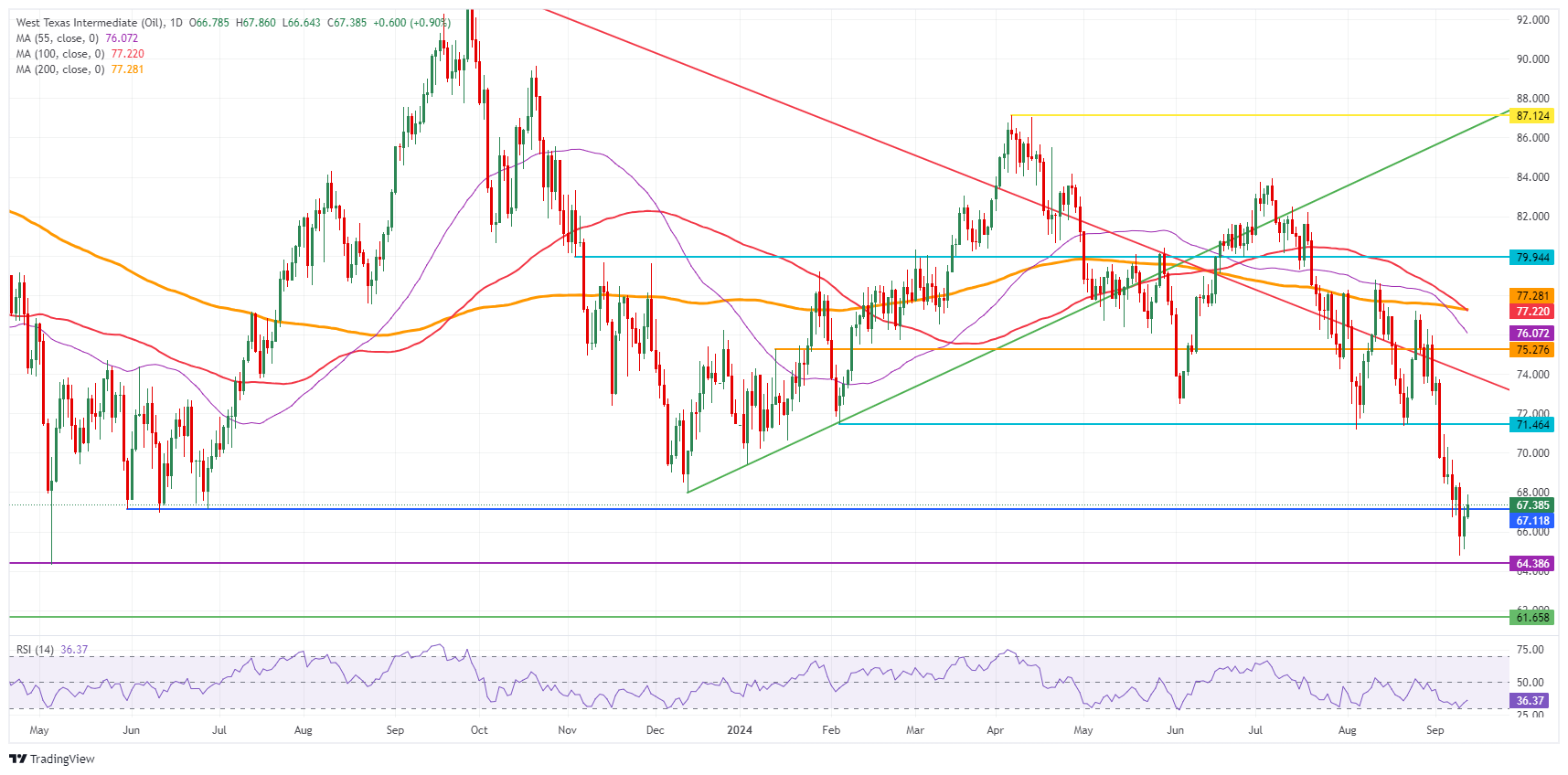- Crude oil sees rallies holding for now with concerns over US crude production being priced in.
- Tropical Storm Francine has hit Louisiana, shutting down oil production in the region.
- The US Dollar Index is trading above 101.50 and testing the upper limit of its band for an upside breakout.
Crude oil is up more than 1.00% for the second day in a row after posting more than 1.50% gains on Wednesday, which was the biggest daily gain for crude oil in two weeks. The rise comes amid growing concerns about the impact of Tropical Storm Francine on U.S. production and after OPEC’s most recent report, which lowered the oil demand outlook, was deemed unrealistic considering recent U.S. and global economic activity.
The US Dollar Index (DXY), which tracks the performance of the US Dollar (USD) against a basket of currencies, is stronger and testing the upper band of its narrow band in which it has been trading for more than two weeks. The stronger Dollar emerged after US Consumer Price Index data revealed an unexpected rise in the monthly core measure. That closed the door to a 50 basis point rate cut by the US Federal Reserve next week, supporting the US Dollar.
At the time of writing, WTI crude oil is trading at $67.70 and Brent Crude at $71.29
Oil and Markets News: US markets wake up to Storm Francine in hand
- The International Energy Agency (IEA) released its monthly report, which showed that the recent disruption in Libya caused a 70,000 barrel per day decline in OPEC’s daily output. Libya’s supply fell by 180,000 barrels per day to 980,000, Bloomberg reported.
- The IEA also reported that supply from Gulf producers remained largely stable, with Saudi Arabia’s output unchanged at 9.01 million barrels per day, Iraq at 4.38 million b/d, UAE at 3.3 million b/d and Kuwait at 2.52 million b/d, Reuters reports.
- In the US, Tropical Storm Francine has hit the Louisiana coast, reaching Category 2 strength. Oil and gas companies had previously evacuated platforms in the Gulf of Mexico, Reuters reported.
- Bloomberg reports that the VLCC Degas, carrying 2 million barrels of Venezuelan crude, has docked at the port of Sikka in India. Delivery could take place after the US government issues an approval outside the current embargo.
Technical Analysis of Oil Prices: OPEC to further sink crude oil prices
The price of crude oil is primed for volatility, and it has no one but OPEC to thank for it. Still, the chances of further declines seem greater than the potential for a rebound. If OPEC adjusts its policy and prolongs production cuts, or extends them, markets could interpret this as a sign of weakness and perceive the situation to be much more dire than anticipated. Should it do nothing, markets will likely remain focused on the supply glut.
Oil has a long way to go before breaking above $75 again. First up is the $67.11 level, which needs to see a daily close above at least. Once that level is reclaimed, $70.00 is back on the table with $71.46 as the first level to watch. Ultimately, a return to $75.27 remains possible, but is likely due to a seismic shift in current balance sheets.
The next level below is $64.38, the low of March and May 2023. If that level faces a second test and is broken, $61.65 becomes a target, with of course $60.00 as a psychologically important figure just below, at least tempting to be tested.
WTI Crude Oil Daily Chart
Brent Crude FAQs
Brent crude oil is a type of crude oil found in the North Sea that is used as a benchmark for international oil prices. It is considered “light” and “sweet” due to its high gravity and low sulfur content, making it easy to refine into gasoline and other high-value products. Brent crude oil serves as a benchmark price for approximately two-thirds of the world’s internationally traded oil supplies. Its popularity is based on its availability and stability: the North Sea region has a well-established infrastructure for oil production and transportation, ensuring a reliable and steady supply.
Like all assets, supply and demand are the key drivers of the Brent crude oil price. As such, global growth can be a driver of higher demand and vice versa for weak global growth. Political instability, wars and sanctions can disrupt supply and affect prices. Decisions by OPEC, a group of major oil producing countries, are another key driver of price. The value of the US Dollar influences the Brent crude oil price as oil is predominantly traded in US Dollars, so a weaker US Dollar can make oil more affordable and vice versa.
Weekly oil inventory reports released by the American Petroleum Institute (API) and the Energy Information Agency (EIA) impact the price of Brent crude oil. Changes in inventories reflect fluctuating supply and demand. If the data shows a drop in inventories, it may indicate an increase in demand, which pushes up the price of oil. Higher inventories may reflect an increase in supply, which pushes down prices. The API report is released every Tuesday, and the EIA report the following day. Their results are usually similar, within 1% of each other 75% of the time. The EIA data is considered more reliable, as it is a government agency.
OPEC (Organization of the Petroleum Exporting Countries) is a group of 13 oil-producing nations that collectively decide production quotas for member countries at semi-annual meetings. Their decisions often affect Brent crude oil prices. When OPEC decides to reduce quotas, it can restrict supply, driving up oil prices. When OPEC increases production, it has the opposite effect. OPEC+ refers to an expanded group that includes ten additional non-OPEC members, the most notable of which is Russia.
Source: Fx Street
I am Joshua Winder, a senior-level journalist and editor at World Stock Market. I specialize in covering news related to the stock market and economic trends. With more than 8 years of experience in this field, I have become an expert in financial reporting.








